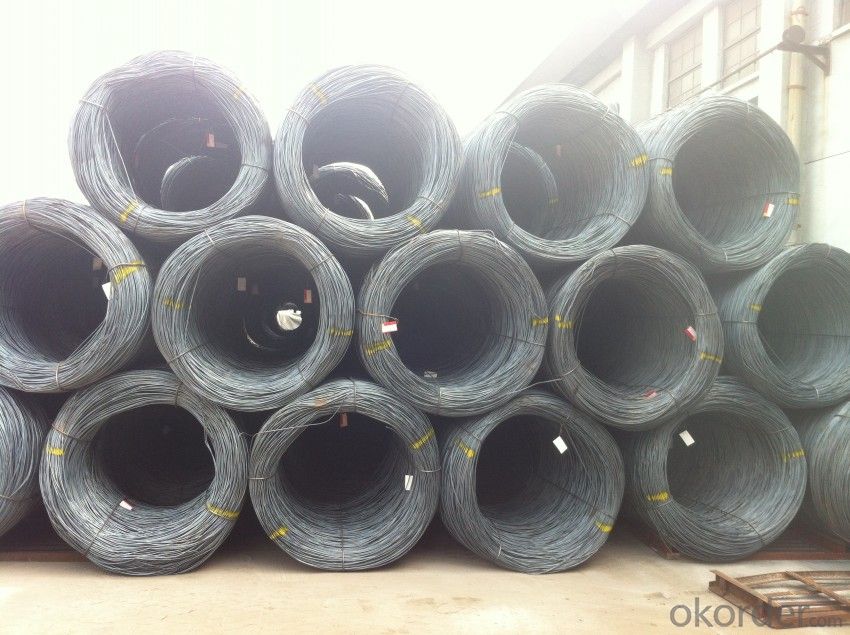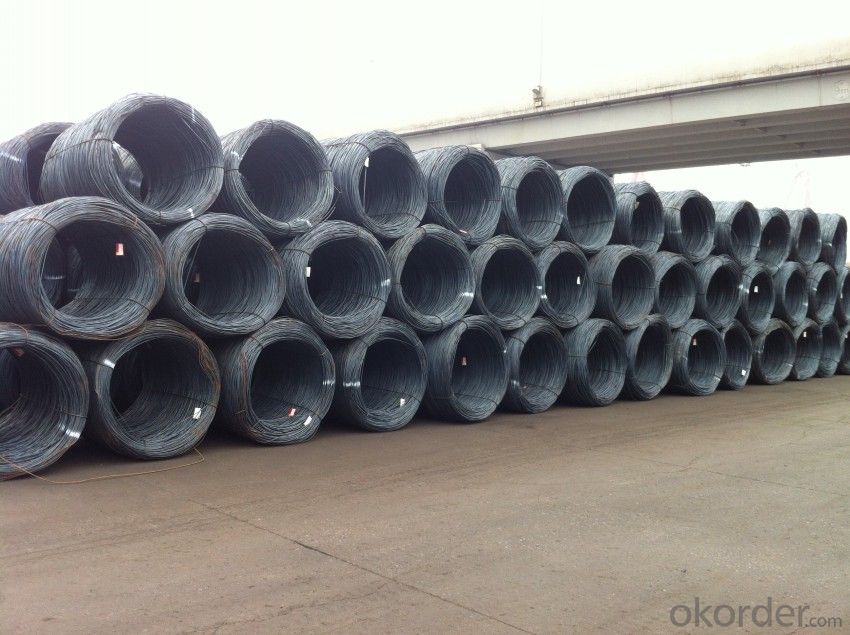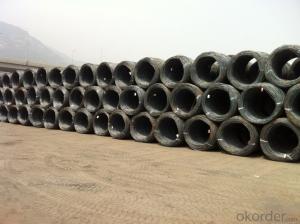Hot Rolled Wire Rods in Material Grade SAE1008
- Loading Port:
- Tianjin
- Payment Terms:
- TT OR LC
- Min Order Qty:
- 25 m.t.
- Supply Capability:
- 20000 m.t./month
OKorder Service Pledge
OKorder Financial Service
You Might Also Like
Item specifice
Grade: SAE1008 Standard: ASTM
Diameter: 5.5mm, 6.5mm, 7mm, 8mm, 9mm, 10mm, 11mm, 12mm
Alloy or Not: Alloy
Technique: Hot Rolled Place of Origin: China Mainland
Chemical Composition:
Please kindly find our chemistry of our material based on SAE1008 as below for your reference:
Grade | Chemical Composition (%) | |||||
C | Mn | S | P | Si | B | |
SAE1008 | 0.10max | 0.30-0.50 | 0.050max | 0.040max | 0.30max | 0.0008min |
Mechanical properties | ||||||
Yield strength(N/mm2) | Tensile strength(N/mm2) | Elongation (%) | ||||
≥195 | 350-380 | ≥32 | ||||
Usage and Applications of SAE1008 Steel Wire Rod:
After hot-rolled the products shaped into coil and delivery as finished product, including round, square,rectangular, hexagonal and so on. Since most of the products are round, it is generally called wire rod. Carbon steel wire rod is widely used in construction and manufacturing. Carbon steel wire rod is mainly used for reinforcement of reinforced concrete and welded structure or reprocessed (roberts , nail, etc.) materials, especially used to produce wire drawing, welding electrode, nails, spring, electronic, precise machinery parts and so on.
Packaging & Delivery of SAE1008 Steel Wire Rod:
Packaging Detail: products are packed in coil and then shipped by container or bulk vessel
Each coil weight: About 2.05MT
Delivery Detail: within 45 days after received deposit or LC.
Label: to be specified by customer, generally, each bundle has 1-2 labels
Trade terms: FOB, CFR, CIF
FAQ:
Q1: How soon can we receive the product after purchasement?
A1: Within three days of placing an order, we will begin production. The specific shipping date is dependent upon international and government factors, but is typically one month.
Q2: How do you guarantee the quality of our products?
A2: We have established an advanced quality management system which conducts strict quality tests at every step, from raw materials to the final product. At the same time, we provide extensive follow-up service assurances as required.
Q3: Why buy Materials & Equipment from OKorder.com?
A3: All products offered by OKorder.com are carefully selected from China's most reliable manufacturing enterprises. Through its ISO certifications, OKorder.com adheres to the highest standards and a commitment to supply chain safety and customer satisfaction.
Images of SAE1008 Steel Wire Rod


- Q:What are the common production processes for protactinium-coated steel wire rod?
- The common production processes for protactinium-coated steel wire rod typically involve several steps. First, the steel wire rod is thoroughly cleaned and prepared to ensure its surface is free of any contaminants. Then, a layer of protactinium is applied to the steel wire rod using a specialized coating technique such as electroplating or chemical vapor deposition. This process ensures a uniform and durable coating of protactinium on the wire rod. Finally, the coated wire rod is carefully inspected and tested for quality control before it can be used in various applications.
- Q:What are the common defects in steel wire rod?
- There are several common defects that can be found in steel wire rods. These defects can affect the overall quality and performance of the wire rods. Some of the most common defects include: 1. Surface defects: Surface defects such as cracks, scratches, and pits can occur during the manufacturing process or due to improper handling. These defects can weaken the wire rod and reduce its durability. 2. Internal defects: Internal defects like seams, laps, and inclusions can occur during the casting or rolling process. These defects can lead to weak spots in the wire rod, making it more prone to breakage under stress. 3. Size and shape defects: Wire rods should have a uniform size and shape to ensure consistent performance. Defects such as variations in diameter, ovality, or improper coiling can affect the wire rod's ability to be used in certain applications. 4. Non-metallic inclusions: Non-metallic inclusions such as oxides, sulfides, and silicates can be present in steel wire rods. These inclusions can reduce the wire rod's strength and ductility, making it more susceptible to failure. 5. Decarburization: Decarburization occurs when the carbon content at the surface of the wire rod is reduced, leading to a softer and weaker outer layer. This defect can affect the wire rod's ability to withstand stress and deformation. It is important to note that the severity and frequency of these defects can vary depending on the manufacturing process and quality control measures implemented by the steel wire rod producer. Regular inspection and testing can help identify and mitigate these defects to ensure the quality and reliability of the wire rods.
- Q:How is steel wire rod used in the construction of bridges and buildings?
- Steel wire rod is commonly used in the construction of bridges and buildings due to its high tensile strength and durability. It is primarily used as a reinforcement material to create stronger and more structurally sound structures. In the construction of bridges, steel wire rod is often used in the form of reinforced concrete. By embedding the steel wire rod within the concrete, it adds tensile strength to the structure, allowing it to withstand heavy loads and prevent cracking or collapsing under stress. This reinforcement is crucial in ensuring the longevity and stability of the bridge, especially in areas with high traffic or seismic activity. Similarly, in the construction of buildings, steel wire rod is used in reinforced concrete columns, beams, and slabs. These elements are essential for supporting the weight of the building and distributing it evenly throughout the structure. By reinforcing these components with steel wire rod, the building gains the strength and flexibility needed to handle various loads, including live loads (such as furniture and people) and dead loads (such as the weight of the structure itself). Additionally, steel wire rod is also utilized for pre-stressed concrete applications. In this technique, the steel wire rod is tensioned before the concrete is poured, creating compression within the concrete. This compression helps counteract the tensile forces that the structure may experience, improving its overall strength and reducing the risk of cracking or deformation. Overall, the use of steel wire rod in the construction of bridges and buildings enhances their structural integrity, increases their load-bearing capacity, and improves their resistance to external forces. Its versatility and strength make it an ideal material for ensuring the safety and longevity of these critical infrastructure projects.
- Q:How is steel wire rod used in the production of tire cords?
- Tire cords rely on steel wire rod, an indispensable element, for their production. These cords are embedded within the rubber of tires to offer strength and support. The steel wire rod undergoes a sequence of steps to achieve the desired form for tire cord manufacturing. To begin with, the steel wire rod undergoes hot rolling, which reduces its diameter and increases its length. This process enhances the wire rod's strength and flexibility, making it suitable for tire cord applications. Following hot rolling, the wire rod is subjected to a heat treatment known as patenting. This treatment improves the wire's mechanical properties, such as tensile strength and elasticity, ensuring it can endure the demanding conditions tires face. Once appropriately processed, the steel wire rod is drawn through a series of dies to attain the desired diameter and surface finish. This drawing process further enhances the wire's strength and surface quality, meeting the strict requirements for tire cord production. Next, the drawn steel wire rod is coated with a layer of brass or zinc to enhance its adhesion to the rubber compound used in tire manufacturing. This coating also provides corrosion resistance, extending the lifespan of the tire cords. Lastly, the coated steel wire rod is twisted into cord structures with multiple strands, forming the tire cord. These cords are then embedded into the rubber during the tire manufacturing process. They play a vital role in reinforcing the tire, enabling it to withstand internal pressure, external forces, and maintain stability during vehicle movement. In conclusion, steel wire rod is an essential material in the production of tire cords. Through a series of processing steps, including hot rolling, heat treatment, drawing, and coating, the wire rod is transformed into durable and high-strength cords. These cords are embedded within the rubber of tires to provide crucial reinforcement and support, ensuring the tires can endure the challenging road conditions they encounter.
- Q:How is steel wire rod used in the manufacturing of window and door frames?
- Steel wire rod is commonly used in the manufacturing of window and door frames due to its strength and durability. The steel wire rod is typically used as a reinforcement material to provide structural support and stability to the frames. During the manufacturing process, the steel wire rod is first subjected to a series of mechanical and chemical treatments to enhance its strength and resistance to corrosion. This process involves cleaning, descaling, and coating the wire rod to ensure its suitability for use in window and door frames. Once the steel wire rod is prepared, it is then shaped and formed into the desired frame structure. This can be done through various techniques such as bending, welding, or using specialized machinery to mold the wire rod into the required shape and size. The steel wire rod is then integrated into the window or door frame structure, typically by being welded or fastened together with other components. This helps to improve the overall strength and stability of the frame, ensuring that it can withstand the weight and pressure exerted on it. Additionally, the use of steel wire rod in window and door frames provides added security and resistance against break-ins. The high tensile strength of the steel wire rod makes it difficult to bend or break, making it a reliable material for ensuring the safety of residential or commercial premises. Overall, the use of steel wire rod in the manufacturing of window and door frames offers numerous benefits, including increased strength, durability, and security. It ensures that the frames can withstand the test of time, provide structural integrity, and enhance the aesthetic appeal of any building.
- Q:What are the safety precautions to be followed while working with steel wire rod?
- When working with steel wire rods, there are several safety precautions that should be followed: 1. Wear appropriate personal protective equipment (PPE) such as gloves, safety goggles, and protective clothing to protect against cuts, abrasions, and eye injuries. 2. Ensure that the work area is clean and free from any obstacles or clutter that may cause tripping or slipping hazards. 3. Use the correct tools and equipment for handling and cutting steel wire rods. Ensure that tools are in good condition and properly maintained. 4. Familiarize yourself with the proper handling techniques for steel wire rods. Avoid sharp or sudden movements that may cause the wire rod to whip or recoil. 5. Keep a safe distance from other workers to prevent accidental contact with the wire rod. 6. Store steel wire rods in a secure and stable manner to prevent them from rolling or falling. 7. Use caution when cutting or bending steel wire rods, as these actions can create sharp edges or flying debris. Always cut away from your body and use appropriate cutting tools. 8. Be aware of the weight and length of the wire rod you are handling, as they can be heavy and difficult to control. Avoid overexertion and seek assistance if needed. 9. Follow proper lifting techniques when moving or transporting steel wire rods. Bend your knees, keep your back straight, and use your leg muscles to lift and carry the rods. 10. In case of any injury or accident, seek immediate medical attention and report the incident to your supervisor. It is important to always prioritize safety when working with steel wire rods, as they can pose various hazards if not handled properly.
- Q:What are the advantages of using alloyed steel wire rod?
- There are several advantages of using alloyed steel wire rod. Firstly, alloying steel with other elements enhances its strength and durability, making it suitable for various applications that require high tensile strength. Secondly, alloyed steel wire rod offers improved resistance to corrosion, oxidation, and wear, making it ideal for use in outdoor or harsh environments. Additionally, alloyed steel wire rod exhibits better formability and weldability, allowing for easier processing and fabrication. Lastly, the use of alloyed steel wire rod can lead to cost savings as it often requires less maintenance and replacement compared to other materials.
- Q:What are the different production processes for steel wire rod?
- There are several different production processes for steel wire rod, including the basic oxygen furnace (BOF) process, the electric arc furnace (EAF) process, and the continuous casting process. The BOF process involves melting iron ore in a furnace and then blowing oxygen through it to remove impurities and adjust the carbon content. The EAF process uses electricity to melt scrap steel and then refine it through the addition of alloys and fluxes. The continuous casting process involves continuously casting molten steel into a billet or slab shape, which is then rolled into wire rod.
- Q:How is steel wire rod transported and stored?
- Steel wire rod is typically transported and stored in large coils or bundles. These coils are loaded onto trucks, trains, or ships for transportation to various destinations. When it comes to storage, steel wire rod is often stacked in warehouses or outdoor yards, with proper measures taken to ensure stability and prevent damage. Additionally, the coils can be stored on racks or placed on flat surfaces to maintain their shape and prevent tangling.
- Q:Can steel wire rod be used in the production of springs?
- Yes, steel wire rod can be used in the production of springs. Steel wire rod is a commonly used material for making springs due to its high strength, durability, and flexibility. It can be easily shaped and formed into various spring designs, such as compression springs, extension springs, and torsion springs. The steel wire rod is typically processed through a series of manufacturing steps, including drawing, coiling, heat treatment, and surface finishing, to achieve the desired properties and specifications for the specific application of the spring. Overall, steel wire rod is an excellent choice for spring production due to its mechanical properties and suitability for various industrial and commercial applications.
1. Manufacturer Overview |
|
|---|---|
| Location | |
| Year Established | |
| Annual Output Value | |
| Main Markets | |
| Company Certifications | |
2. Manufacturer Certificates |
|
|---|---|
| a) Certification Name | |
| Range | |
| Reference | |
| Validity Period | |
3. Manufacturer Capability |
|
|---|---|
| a)Trade Capacity | |
| Nearest Port | |
| Export Percentage | |
| No.of Employees in Trade Department | |
| Language Spoken: | |
| b)Factory Information | |
| Factory Size: | |
| No. of Production Lines | |
| Contract Manufacturing | |
| Product Price Range | |
Send your message to us
Hot Rolled Wire Rods in Material Grade SAE1008
- Loading Port:
- Tianjin
- Payment Terms:
- TT OR LC
- Min Order Qty:
- 25 m.t.
- Supply Capability:
- 20000 m.t./month
OKorder Service Pledge
OKorder Financial Service
Similar products
New products
Hot products
Related keywords



























